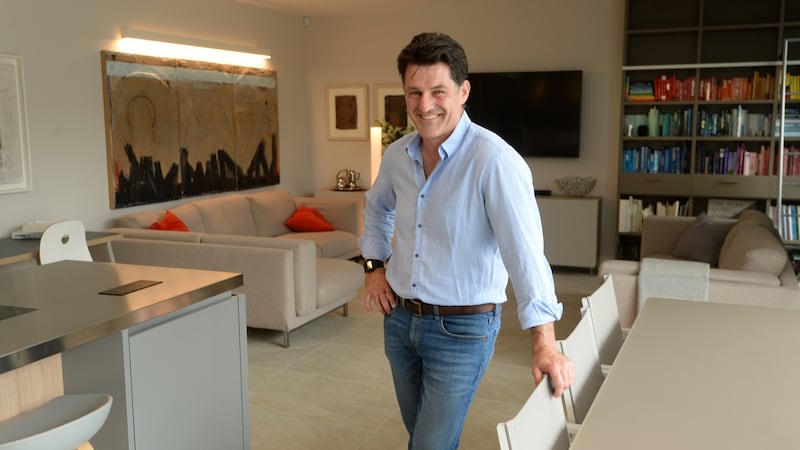When the klaxon for the next general election sounds – maybe this time next year, maybe a few months later – one issue which will be the subject of white-hot debate during the ensuing campaign will be housing.
The stakes are high.
The amount of progress that this Government makes – or does not make – could change the trajectory of Irish politics in potentially historic ways.
If voters decide that not enough has been done, they may turn to Sinn Féin, which has invested heavy political capital in promising to fix the crisis. Along with health, housing will be the definitive yardstick by which the current Government will be judged.
RM Block
Ministers have not been shy about flogging their glossy “Housing for All” plan and have spent much of this week boasting that this year’s targets will be exceeded and that this will be a record decade for the building of social houses.
But with the clock ticking ahead of local elections and a general election, what is the full picture?
Even Opposition parties accept that meeting the target of 29,000 new homes this year will be a welcome development and one the Government can rightfully trumpet. But the picture beneath the headline figure is not quite as simple. So, are they meeting their targets? Or it is smoke and mirrors?
Affordable homes
In 2022, the target set for affordable homes was 4,100. The actual number delivered was 1,757.
Digging a little deeper, however, the reality is a bit more complicated.
Ministers this week could not say how many affordable homes have been delivered up to the end of September, despite holding a press conference on progress made in that exact time period
Some 750 of those 1,757 homes are described as being from the First Home Scheme, where the buyer cedes some equity in the home to the State. According to official scheme data, 750 is actually the number of approvals in principle for 2022. The number of actual drawdowns for the year was only 137. Given all this, it is safe to say that the Government missed its affordable targets last year by a very wide margin.
Moving to this year, the target for affordable homes is 5,500.
Ministers this week could not say how many affordable homes have been delivered up to the end of September, despite holding a press conference on progress made in that exact time period.
The most recent figures available are for the first six months of this year and they show that just 1,290 affordable houses were built in that time. Government figures do believe that there will be a sizeable uptick in the last few months of the year but as things stand, the numbers are not yet there.
Social housing
The Government’s target for social housing new builds last year, the first full year of the Housing for All plan, was 9,000. The final figure delivered was 7,500.
The target this year is for 9,100 new social builds. Will they meet it?
Again, ministers could not this week say how many new social homes have been built until the end of September. But figures for the first six months of the year show only 1,401 new social builds have been completed.
While officials privately insist that they will go well above the 7,500 homes rolled out last year, no one has confidently said that the Government will make the target, and once again, the figures for the first part of the year are not encouraging.
Mel Reynolds, architect and housing policy analyst, has undertaken a detailed analysis of the social housing output over the last number of years. He says output of social housing has “been persistently low” and that numbers from the department “need to be unpicked very carefully because the headlines are usually misleading”.
[ Threshold sees 12% rise in number of households at risk of homelessnessOpens in new window ]
Reynolds says housing output by local authority is the best metric by which to judge output. He says that, according to figures he has interrogated, last year the total number of local authority social builds on State lands was 1,689. In the four Dublin local authorities 476 social homes were built, he says.

He says that almost 5,000 of the social homes the Government delivered last year were actually turnkey purchases from the private sector, not State-built homes on local authority lands.
So that means “nearly 70 per cent of the Government’s headline figure quoted as new build social were actually purchased from private sector,” he says.
The upshot is: the targets have so far been missed, even with a huge reliance on the private sector.
Homelessness
Compared with the month that Housing for All plan was first published, September 2021, there has been a 33 per cent increase in the number of homeless people. The Coalition’s flagship housing plan promised to find a path to eradicate homelessness by 2030. However, sources in the Department of Housing believe the current situation will remain for a number of years before numbers drop in any meaningful way, making this one of the most outright failures of the Government’s plan.
[ Local authority loan to be available for derelict homes under Government plansOpens in new window ]
In all, 29,851 residential units were completed in 2022, of which 9,148 were completed in the final three months of the year, according to figures released by the Central Statistics Office (CSO). Therefore the Government exceeded its overall target of 24,600 last year.
Of the overall figure, 9,166 were apartments, which is up almost 80 per cent compared with 2021. More than 10,000 were houses in housing estates of one form or another. The target for this year is 29,000, and Taoiseach Leo Varadkar said this week that he believes this target will be met.
Rental sector
When the Housing For All plan was published in September 2021, monthly rents in Dublin were averaging €2,082, according to the Daft.ie quarterly report from the time. This was up 107 per cent from a low in 2011. The average rent nationally in 2021 was €1,516 a month.
There are potential green shoots in terms of rental supply. On November 1st, there were almost 1,800 homes available to rent nationwide, compared to fewer than 1,100 on the same date a year ago
Two years later, monthly rents across Dublin are averaging €2,330 while the average rent nationally is €1,823, an increase of almost 12 per cent for Dublin rents and 20 per cent for national rents in those intervening years. A chronic lack of supply, exacerbated during the pandemic, has kept the squeeze on renters.
Lorcan Sirr, a senior lecturer in housing, says the increase is notable “especially in the context of a 2 per cent annual rent increase cap, which would raise questions about its effectiveness.”
There are potential green shoots in terms of rental supply, however.
On November 1st, there were almost 1,800 homes available to rent nationwide, compared to fewer than 1,100 on the same date a year ago. Of the increase of almost 700 homes, Dublin accounted for over 600. Sirr says this is likely to be build-to-rents rather than small landlords coming back into the market.
The big plan in Housing for All in terms of the rental sector was to vastly increase the roll-out of cost-rental units to 2,000 a year.
Cost rental is aimed at people who earn above social housing caps but struggle to pay market rents. Under the cost-rental scheme, the rent paid is based on the cost of building, managing and maintaining the homes, and not market rates.
Some 684 cost-rental homes were rolled out last year. Figures for the first six months of this year show only 22 cost-rental homes were delivered in that period.
First-time buyers and house prices
First-time buyer activity appears to be approaching, if not exceeding, Celtic Tiger levels. The Banking and Payments Federation Ireland said that a record number of first-time buyer mortgages – 29,754 – were approved in the year to the end of July. The schemes they are using include the First Homes shared equity scheme and the Help to Buy scheme, which has been extended until the end of 2025, both of which have proven contentious with the Opposition.
Mel Reynolds says that on his analysis, there have been 2,713 nationwide purchases by first-time buyers in the first seven months of the year. He sourced this information from stamp duty transactions. The majority of first-time buyers are also buying second-hand homes, he says, which paints a picture of how out of reach new homes are for some first time buyers.
Vacancy and dereliction
Green Party leader Eamon Ryan this week declared his pride in the level of uptake around the vacancy and refurbishment grants worth up to €70,000. Minister for Housing Darragh O’Brien announced that he would double his target of 2,000 renovations after already passing 4,100 grant applications.
However, Sinn Féin housing spokesman Eoin Ó Broin uncovered information that only 21 grants have actually been drawn from April of last year until September this year.
Ambition
It is universally accepted that the Government’s targets – even the ones it is missing – are too low. Minister for Enterprise, Trade and Employment Simon Coveney said earlier this year that the actual level of new builds should be somewhere between 40,000 and 50,000 a year.

To this end, the Economic and Social Research Institute (ESRI) has been asked to look at population trends and other metrics and advise the Government what the actual number should be in the years to come. After this, the Housing for All targets will be revised upwards.
A significant €5.1 billion in capital investment has been allocated to housing delivery in Budget 2024, with hundreds of millions put aside for affordability measures such as cost rental
There is a catch, though. This figure will not emerge until next year, and the actual breakdown of social, affordable and private homes will not be revealed until late 2024, by which stage the country could be in the grip of a general election, or on the precipice of one. That higher ambition will be another Government’s problem.
Verdict
There are upsides: up to the end of September, some 22,400 homes have been completed. Across all levels of Government, politicians have said that they plan to significantly exceed the target of 29,000 new builds by the end of the year. Housing commencements are up 14 per cent on last year, so there is a solid pipeline of new builds in the future. A significant €5.1 billion in capital investment has been allocated to housing delivery in Budget 2024, with hundreds of millions put aside for affordability measures such as cost rental.
[ Scale of homeless crisis is far worse than official figures suggestOpens in new window ]
On the other side, there are record numbers of homeless people, and the social and affordable housing targets have so far been missed. Rents are higher and supply is still tight. There is an over-reliance on the private sector across the board, both for building and for private rent subsidies.
Without doubt, progress has been made. But given the fact that the existing targets are inadequate, it’s hard to escape the conclusion that this Government’s five-year push will simply not be enough to stop housing becoming the dominant general election issue once again.












